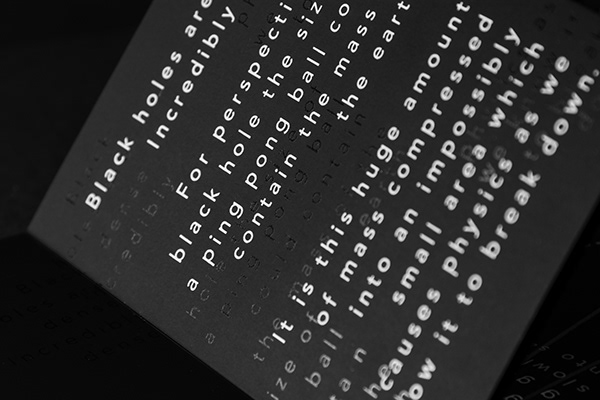The Gallery
Category
Region
Country
School
Status
Order by Behance appreciations
Order by Submitted date
 Filter by Portfolio
All entries
Filter by Portfolio
All entries
 Filter by XD
All entries
Filter by XD
All entries
Entries found
Loading entries
Singularity - A Journey Into a Black Hole
Matthew Gilbert
University of Lincoln, United Kingdom
Print / Graphic
Category Top Talent
Singularity – A typography focused concertina book of the journey into a black hole. Screenprinted on GFSmith 240gsm Plike Black

ISTD 2019 - The Theme of Lost
Singularity
A Journey Into a Black Hole
Black holes are often associated with ‘heavy’ science – large equations, quantum physics and theories surrounding space-time. Whilst black holes and the quantum mechanics surrounding them indeed are complicated, and often require many years of time researching and learning about them to even understand them, they are truly fascinating objects. This gap between the accessibility of information within the scientific world means that for people who haven’t necessarily studied 4 years of physics, this field of science is often hard to get to grips with – even if they are incredibly interested in the matter.


“The black holes of nature are the most perfect macroscopic objects there are in the universe: the only elements in their construction are our concepts of space and time.”
― Subrahmanyan Chandrasekhar
― Subrahmanyan Chandrasekhar


As such, the target audience of this book are people aged 16 and up who have a basic background of science and are interested in this field of science, but don’t necessarily understand the heavy physics side of it. They want to know what happens when you fall into a black hole, but don’t need or even want to know about quantum physics, hawking radiation or the ins and outs of the information loss paradox – they want a guide which tells them what they want to know.

Black holes are anomalies in our universe. They compress matter that weighs hundreds the times of our sun into sizes as small as single atoms. We simply don’t know what happens inside the depths of them as they break all the fundamental principles of science. As such, I wanted to show how a black hole would slowly drag someone in; what it would be like to fall into one, whilst explaining the scientific principles behind it.





Paper Stocks
GFSmith Plike Graphite 240gsm – 2 Sheets A2
GFSmith Plike Black 240gsm – 8 Sheets 180mm x 1020mm

The main element of the book is how it folds out. The concertina style is directly linked to the main concept – when you fall into a black hole, you are literally stretched out and warped – just like how the book stretches out and is literally warped as you read it. Furthermore, the typography gets more and more warped, distorted and eventually destroyed, as you ‘travel’ through the book, mirroring the effects of a black hole.


A major element thematically was the black and white colour scheme. Black holes are so powerful that not even light can escape, and as such, the further you get into the book, more and more colour drains from the page. The spot gloss has been used to show a complete lack of light, where nothing can escape, a complete lack of anything.








T H A N K Y O U